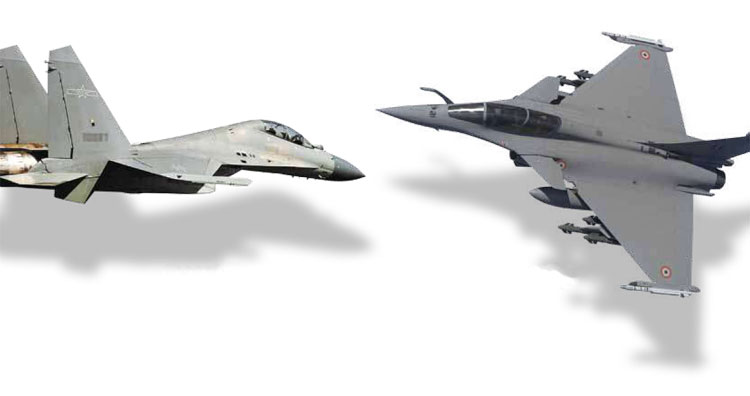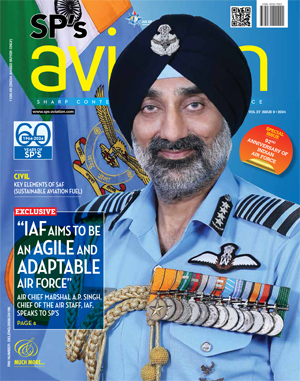INDIAN ARMED FORCES CHIEFS ON OUR RELENTLESS AND FOCUSED PUBLISHING EFFORTS

SP Guide Publications puts forth a well compiled articulation of issues, pursuits and accomplishments of the Indian Army, over the years

"Over the past 60 years, the growth of SP Guide Publications has mirrored the rising stature of Indian Navy. Its well-researched and informative magazines on Defence and Aerospace sector have served to shape an educated opinion of our military personnel, policy makers and the public alike. I wish SP's Publication team continued success, fair winds and following seas in all future endeavour!"

Since, its inception in 1964, SP Guide Publications has consistently demonstrated commitment to high-quality journalism in the aerospace and defence sectors, earning a well-deserved reputation as Asia's largest media house in this domain. I wish SP Guide Publications continued success in its pursuit of excellence.
IAF vs PLAAF in Eastern Ladakh
Would the IAF be able to effectively confront the PLAAF in the event of a large scale conflict that would involve the employment of air power by both sides?

Confrontation along the Line of Actual Control (LAC) between the Indian Army and the People’s Liberation Army (PLA) of China, erupted in the first week of May 2020 following a small but violent clash between the troops deployed in the Pangong lake areas in Eastern Ladakh. This triggered apprehensions of possible escalation of conflict that led to the rapid enhancement in the deployment of troops and heavy weaponry by both sides. The Indian Air Force (IAF) as well as the People’s Liberation Army Air Force (PLAAF) of China, were also placed on high alert and resorted to redeployment of their military aerial platforms and associated ground-based elements to not only protect and support the ground forces in peacetime, but also to cater for any major conflict or an all out war should there be one. Consequently, there was escalation of both military and political tension between the two Asian giants.
EFFORTS AT DISENGAGEMENT
Since the beginning of the face-off in May 2020, the political and military leadership of both India and China have been engaged in dialogue to de-escalate the state of military confrontation and reduce the level of tension along the LAC to obviate a full-scale military conflict along the LAC. So far, 11 rounds of talks between the representatives of the military leadership from both sides have taken place and under the somewhat limited agreement for disengagement reached, both sides have pulled back to a limited extent, their frontline troops, tanks, infantry combat vehicles and artillery guns. However, the situation continues to be tense and the possibility of large-scale military conflict continues to loom large over the horizon. Even while negotiations between India and China for disengagement in Eastern Ladakh are in progress, units of the IAF and the PLAAF remain deployed in the theatre just as they were when the border row was at its peak in the year 2020 and there is no perceptible change in the confrontational posture adopted by both the Air Forces. The question is whether or not the IAF would be able to effectively confront the PLAAF in the event of a large-scale conflict that would involve the employment of air power by both sides.
WHERE DOES THE PLAAF STAND TODAY?
Today, the PLAAF stands as the second largest Air Force in the world after the US Air Force whereas the IAF is the fourth largest. The PLAAF has over 2,000 combat aircraft, which is more than triple the heavily depleted strength the IAF currently has on its inventory which stands at around 600 as against the established strength of around 900. The PLAAF, with its considerably larger fleet of combat aircraft supported by advanced air defence systems, would undoubtedly pose an intimidating challenge for the IAF. Besides, the PLAAF is extremely well supported by its domestic aerospace industry that can produce combat platforms of modern generation in the numbers required. The Indian aerospace industry is lagging behind in this respect and has a long way to go to catch up with the adversary. Besides, as compared with the IAF, the PLAAF has a sizeable long-range strategic bomber fleet and has on its inventory, larger fleets of strategic assets such as airborne warning and control system (AWACS) aircraft, aerial tankers and combat drones.
Today, the PLAAF stands as the second largest Air Force in the world after the US Air Force whereas the IAF is the fourth largest
The PLAAF has redeployed its fleet of combat aircraft opposite the Ladakh sector that includes the indigenous J-series of fighter aircraft including the J-20 which is the latest and the Chinese version of the Sukhoi-30 as also the Xian H-6 strategic bomber. The PLAAF moved into the fifth-generation in 2018 with the induction of the Chengdu J-20 Mighty Dragon that has been produced by China’s Chengdu Aerospace Corporation. The J-20 is the world’s third operational fifth-generation stealth fighter aircraft after the F-22 Raptor and the F-35 Lightning II, both from Lockheed Martin. The Russian fifth-generation stealth fighter, the Sukhoi Su-57 entered service only in December 2020.
OPERATIONS BY COMBAT AIRCRAFT OF PLAAF IN LADAKH
Combat aircraft of the PLAAF undertaking missions in support of their ground forces engaged in a conflict with Indian forces in the mountainous region of Eastern Ladakh, will be operating from their air bases in the Tibet Autonomous Region (TAR) that are all located at altitudes of over 12,000 feet. In recent years, a number of airfields in the TAR have been developed with appropriate infrastructure such as hardened shelters for combat aircraft, extended runways and deployment of additional manpower. The airbases of the PLAAF are at Hotan, Gar Gunsa, Kashgar, Hopping, Dkonka Dzong, Linzhi and Pangat in the Xinjiang and TAR. All these airbases have now been activated for air operations against India. Operations by combat aircraft of the PLAAF will be supported by a network of air defence radars and surface-to-air missile units that provide an effective ground-based, air defence network.
Although the airbases listed above are fully equipped and ready for supporting operations by the PLAAF across the LAC, these airfields in the TAR are located at high altitudes on account of which there are serious limitations on the weapon load and fuel that the combat aircraft of the PLAAF can takeoff with. Aerial refuelling therefore, becomes an inescapable necessity for PLAAF aircraft on strike missions if these are to carry weapon load as per their design capacity. This imposes limitations on the number of strike missions that the PLAAF can undertake against Indian targets in Eastern Ladakh.
One factor that ought to be a matter of concern for the IAF is the possibility of collusion between the PLAAF and the Pakistan Air Force in air operations by the former
However, one factor that ought to be a matter of concern for the IAF is the possibility of collusion between the PLAAF and the Pakistan Air Force (PAF) in air operations undertaken by the former in Eastern Ladakh. Recently, an IL-78 aerial tanker of the PLAAF was observed to be landing at Pakistan’s Skardu, a PAF air base in Gilgit-Baltistan. Besides, PLAAF aircraft operating from PAF airbases will not suffer limitations of weapon load as these airfields are not at high altitude. As the PAF has already offered their airbases in the region for operations by the PLAAF, in the event of an escalation of conflict between India and China, the PAF could well step in and join hands with the PLAAF to strike military targets in Eastern Ladakh.
OPERATIONS BY THE IAF IN EASTERN LADAKH
In response to the menacing posture adopted by the PLAAF, the IAF has also ramped up its preparedness and has deployed its fleets of Sukhoi-30MKI, MiG-29 and Mirage 2000 fighters at the forward air bases to deter the PLAAF from any misadventure or take on the enemy when the need arises. Despite the fact that the PLAAF has larger number of aircraft in its combat fleet, as for operations in the high mountainous region of Ladakh, the IAF has an advantage over the PLAAF in respect of experience in operations at high altitudes. When required, the IAF will undertake combat missions from their permanent air bases in the plains of Punjab as well as in Jammu and Kashmir with no compromise on weapon load and fuel that the combat aircraft are required to carry. Besides, the recent acquisition of the fleet of 22 combat-proven AH-64E Apache attack helicopters, has added significant muscle to the capability of the IAF to undertake strike missions against the units of the PLA such as armoured vehicles or vehicular convoys moving on the roads in the mountainous region of Eastern Ladakh to undertake or support operations on the ground. The fleet of transport aircraft consisting of the C-17 Globemaster III heavy-lift aircraft, the C-130J Super Hercules and An-32 tactical transport aircraft, enables the IAF to execute rapid transfer of equipment and supplies to the areas of operation. Induction of the fleet of 15 CH-47F heavy lift helicopter has considerably enhanced the capability of the IAF to transport heavy equipment and vehicles in the mountainous terrain of Eastern Ladakh.
But what has provided a real boost to the combat capability of the IAF though somewhat limited, is the acquisition of the 36 Rafale fighters whose induction is currently underway and is expected to be completed by the end of next year. Although the Rafale is not a stealth fighter aircraft and is classified as a fourth-generation plus platform, it is in no way less capable operationally as compared to the fifth-generation J-20 of the PLAAF. Despite the fact that the PLAAF has a much larger fleet of combat platforms, the IAF is quite capable and confident of countering any threat posed by the enemy in the regime of air power.





